




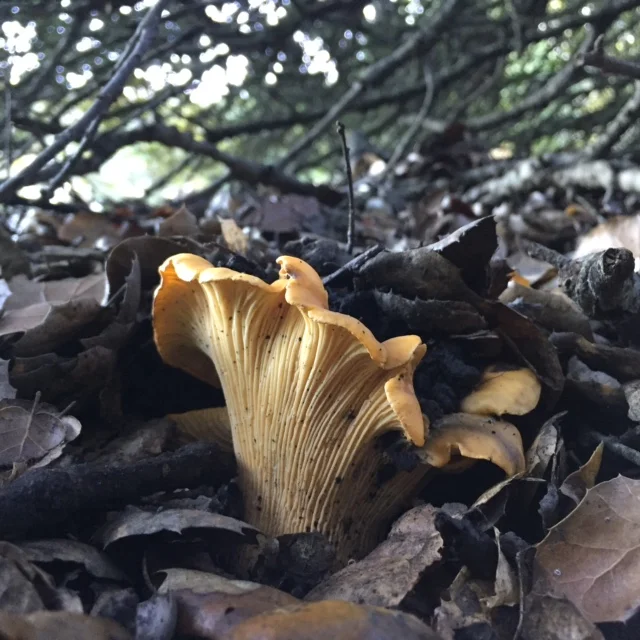
Chanterelles
Cantharellus californicus is the largest species of chanterelle in the world, and we are at their epicenter!


Sweet Pea Tendrils
The tender tips of wild sweet pea vines are one of my favorite Spring edibles. An invasive plant that is abundant, nutritious, and fun to eat - that's my definition of a superfood.


Redbud
Redbud blossoms are not just a vibrant garnish - their flavor stands alone.


Wild Onion
Specifically allium triquetrum, the three-cornered leek. The greens are similar to garlic chive or green onion, but once the flowers start they really steal the show.

Fir Tips
The needles of fir and spruce are most edible when they first emerge from their papery casings each Spring, while they are still tender and before they have developed tannins.
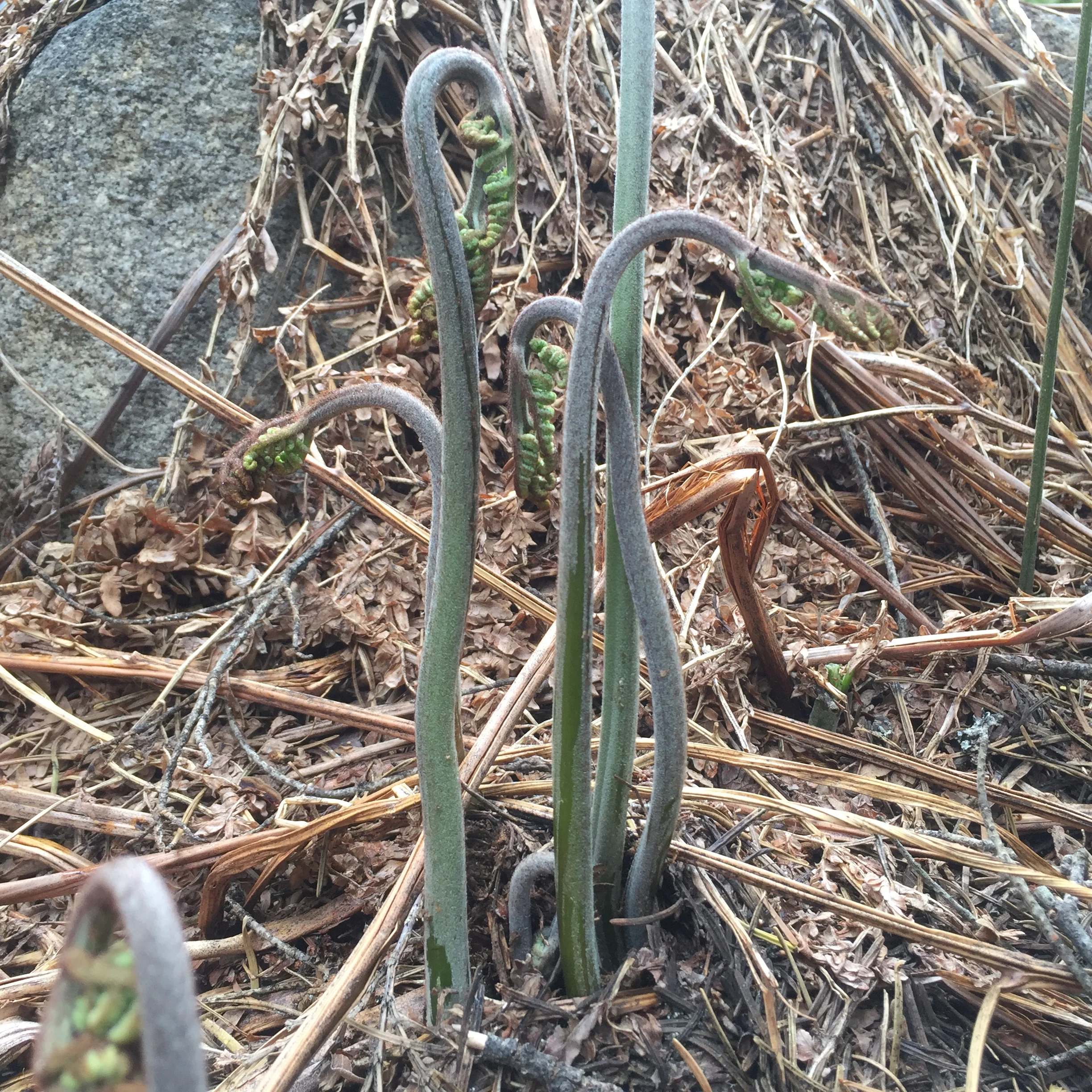
Bracken Fern

Candy Caps
"Dessert mushroom" sounds like a paradox, but sweets are exactly where these little mushrooms shine. With your first whiff you'll experience their intense maple essence.

Black Trumpets
Craterellus cornucopioides, the horn of plenty, more commonly known as black trumpets. Found in mixed forests with tanoak, this is surely one of the finest tasting fungi in our area.

Hedgehogs
Belly-button hedgehogs are a seasonal favorite from our redwood coast. These are delicate mushrooms that need to be handled carefully from pick to pan.


Yellowfoot Chanterelles
The wispy, winter chanterelle fruits in abundance on our north coast wherever the conditions are persistently wet - mossy logs, huckleberry bushes, the edges of gullies or stream beds. Yellowfoot have a flavor most similar to golden chanterelles and texture most similar to black trumpets. This is an under-utilized and under-appreciated wild mushroom.

King Boletes
Boletus edulis, porcini, cep, the king. A charismatic mushroom if there ever was one. Kings appear fleetingly in pine forests after fall and winter rains. The ensuing competition from deer, insects, and crafty mushroom hunters can be intense. Widely regarded as one of the very best wild mushrooms worldwide.

American Matsutake
David Arora describes the aroma of matsutake as "a provocative compromise between 'red hots' and dirty socks." Perhaps it is their unusual and notoriously hard-to-describe flavor that make matsutake so highly prized by chefs.

Spring Kings
Boletus rex-veris is our local Spring porcini. Difficult to find and highly perishable. Everything in the forest wants them from insects to chipmunks, squirrels, deer, and bears. Fortunately they grow fast and sometimes a crafty mushroom hunter can find them first. I get small batches of kings and butter boletes throughout the May to July season. As usual with porcini, we bend to the schedule of the king.
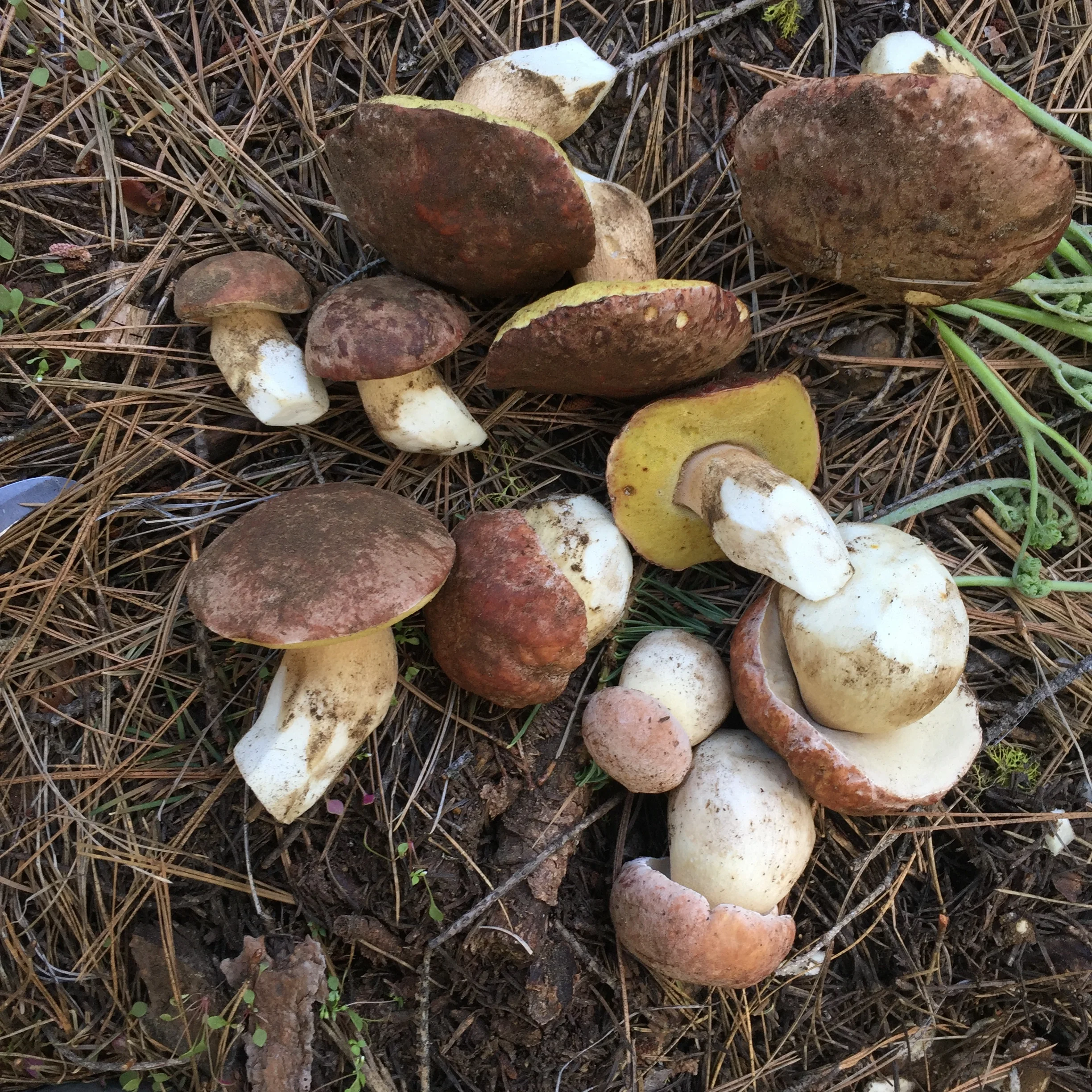

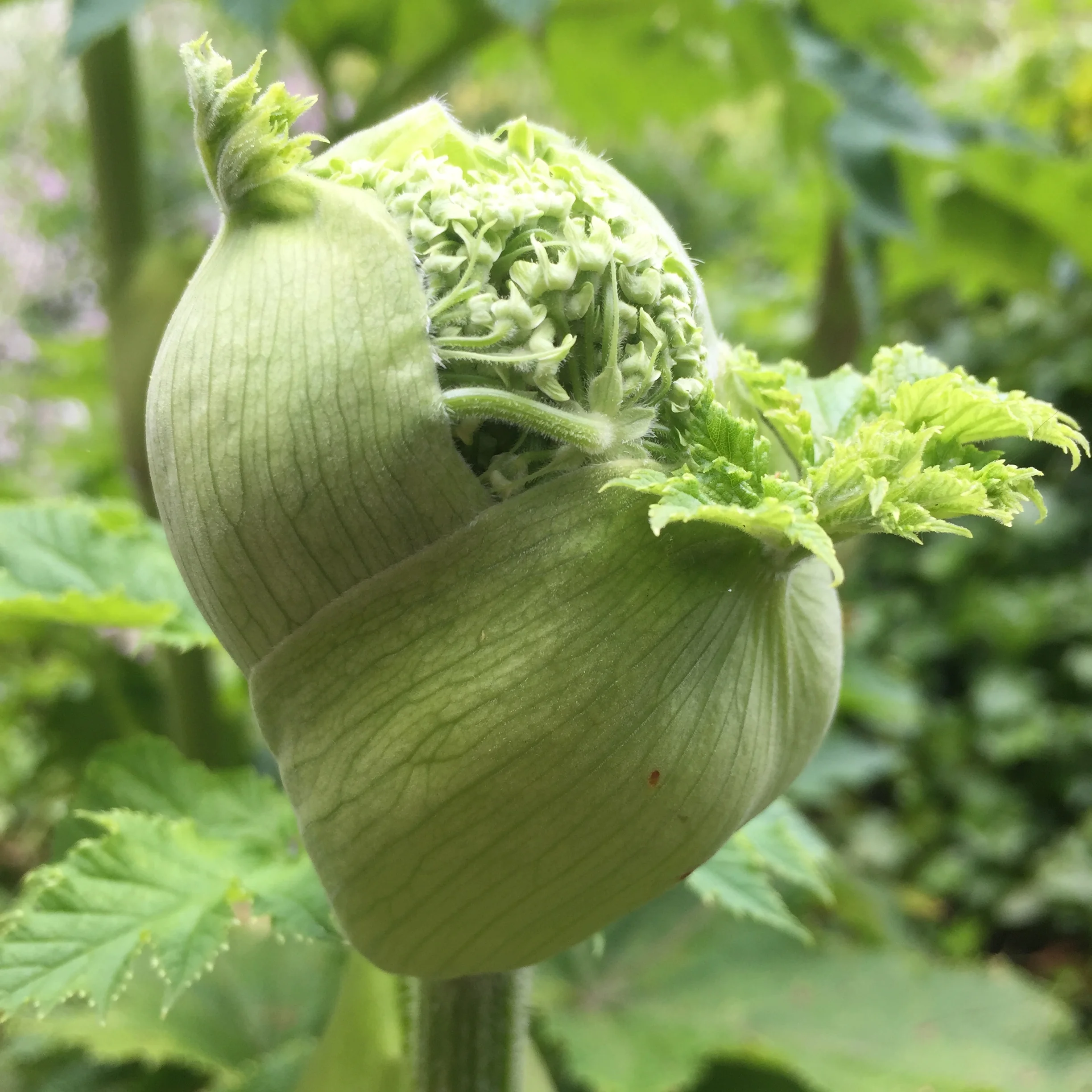


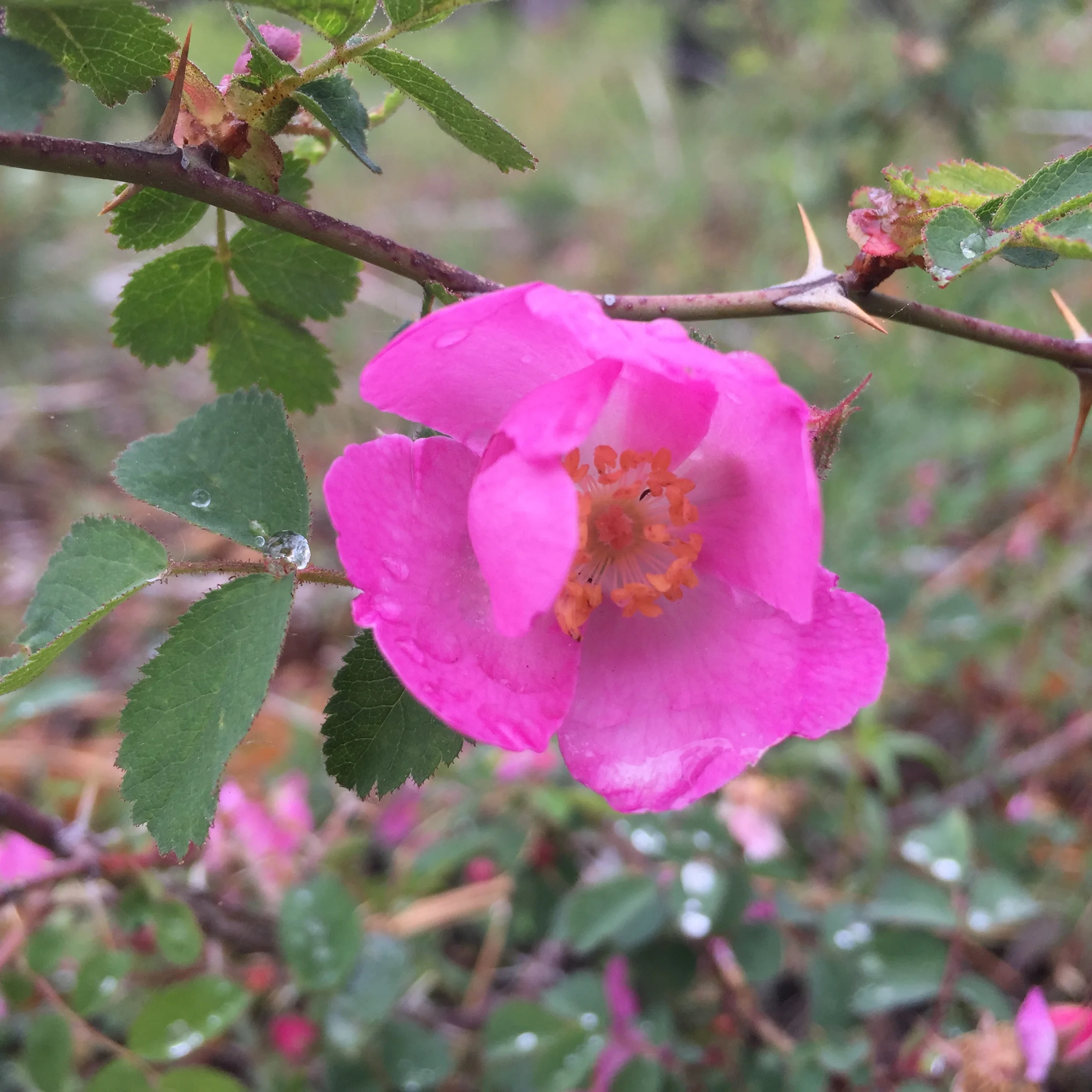
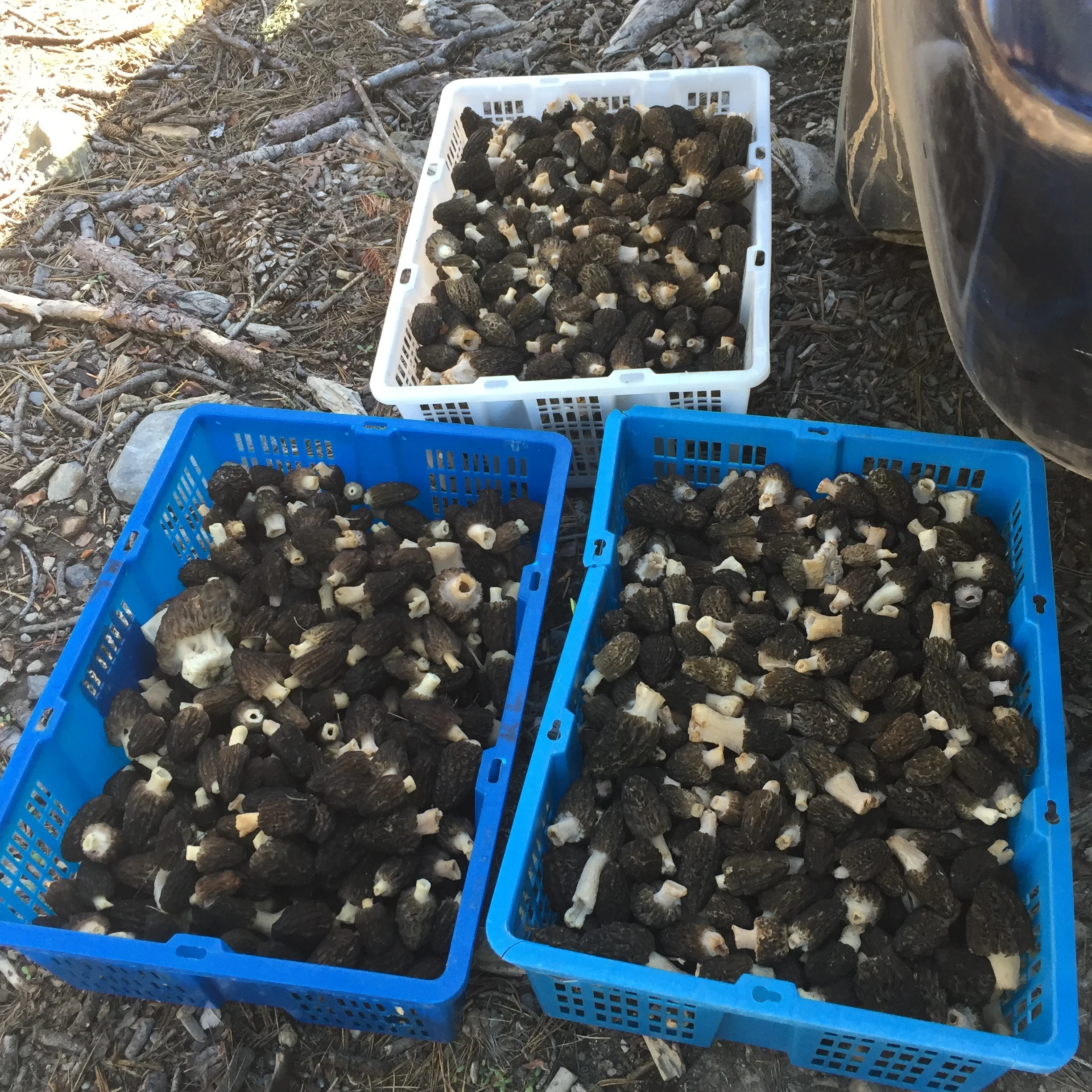

Morchella
It's morel season! My favorite time of year.


Chrysanthemum
Wild chrysanthemum or crown daisy is a welcome weed that's native to the Mediterranean. The tasty greens and striking flower petals are rich in potassium, carotene, and antioxidants.

Daylilies
A uniquely delicious flower whose flavor reminds me of a cross between pumpkin and radish. They come in so many varieties - just let me know what color you're looking for!

Radish and Mustard
"What is a weed? A plant whose virtues have not yet been discovered." -Ralph Waldo Emerson

Miner's Lettuce
Wild food aficionado Hank Shaw describes miner's lettuce as "America's gift to salad." The trick is finding it at just the right stage of maturity and getting to it before the lawn mowers do.

Wild Onion
Invasive three-cornered leeks are booming right now in our area.

Nasturtium
"Peppery" is the word always used to describe nasturtium but it really doesn't do them justice. They are certainly spicy - the flavor reminds me of red hots. This weed is native to the Andes but grows prolifically as an invasive of the California coast. Every part of the plant is edible from the young leaves and vines to the dinner-plate-sized mature leaves to the technicolor flowers and seed-bearing "capers."

Miner's Lettuce
Wild food aficionado Hank Shaw describes miner's lettuce as "America's gift to salad." The trick is finding it at just the right stage of maturity and getting to it before the lawn mowers do.

Oxalis
Wood sorrel, or "sour grass" as we all used to call it as kids, is an abundant invasive weed. The beautiful young greens and flowers will make you pucker because they're loaded with vitamin C. In the Bay Area, I've seen varieties with yellow, purple, and pale pink flowers.
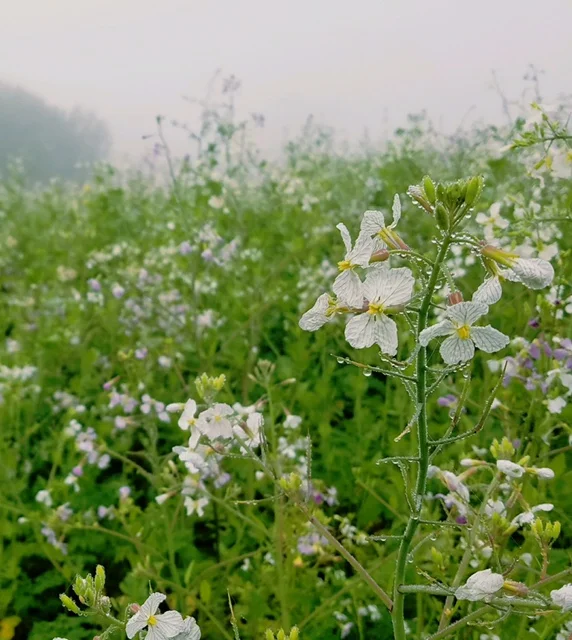


Stinging Nettles
The superfood that bites back.
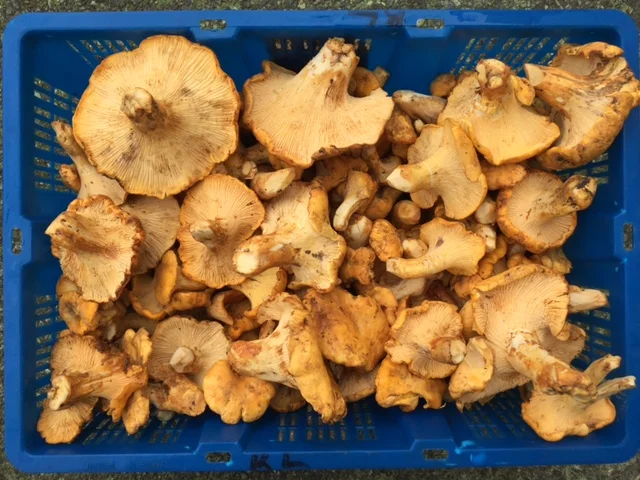

Honey Mushrooms
Armillaria mellea, the honey fungus, is usually found at the base of living or dead trees - especially on stumps. It is a tree pathogen, slowly transforming their wood into delicious mushrooms over the course of many years. Bad news for the tree, good for the forager.


Candy Caps
The season is brief, but the flavor of candy caps intensifies with drying and aging. Now is the time to hit me up if you want them fresh.
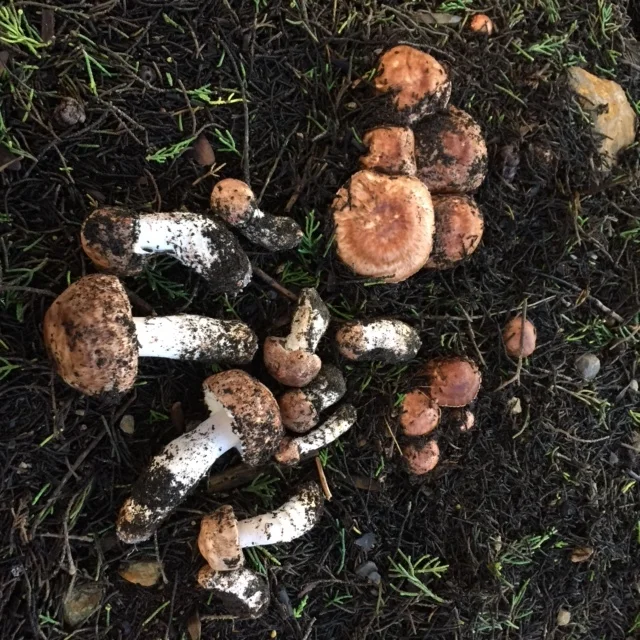
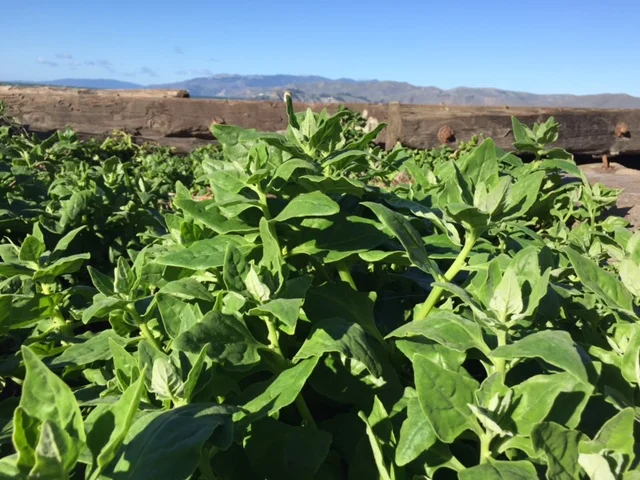
New Zealand Spinach
A nutritious coastal invasive that's naturally salted by the Pacific Ocean.

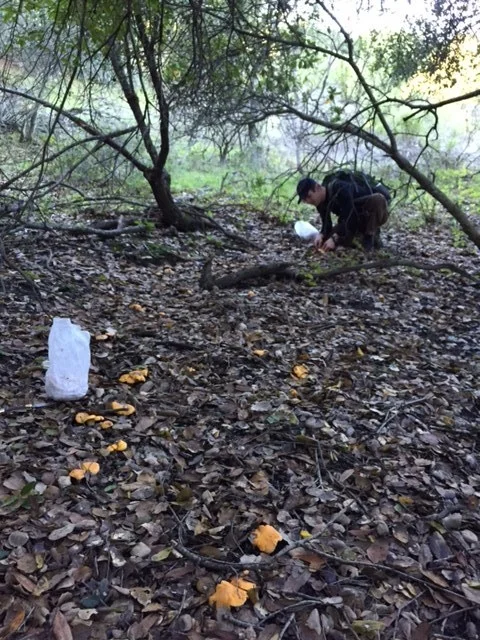

Black Trumpets
Craterellus cornucopioides, the horn of plenty, more commonly known as black trumpets. Found in mixed forests with tanoak, this is surely one of the finest tasting fungi in our area.

Chanterelles (Californicus)
Cantharellus californicus is the largest species of chanterelle in the world, and we are at their epicenter! I think we should celebrate them.


Green Madrone Russula
Russulas are one of the overlooked, unsung heroes of our fungal kingdom. Shrimp russula, olive russula, and green madrone russula are some of the very best mushrooms in our area; sweet, nutty, and often likened to shellfish by the mycophiles who love them.

Matsutake
David Arora describes the aroma of matsutake as "a provocative compromise between 'red hots' and dirty socks." Perhaps it is their unusual and notoriously hard-to-describe flavor that make matsutake so highly prized worldwide.

Porcini
King and queen boletes have made a strong showing this season!

Butter Boletes
These blue-bruising relatives of porcini are equally delicious and choice. Unlike porcini (king, queen, spring king species) they should not be served raw.



Chickweed
'Tis the season for wild greens. I can also get miner's lettuce, wood sorrel, stinging nettle, watercress, and more.




Chanterelles
One of the most prolific mushrooms in our area, a patch of goldens may fruit several times between November and March. Chanterelles are celebrated local delicacies in the Bay Area.

Coccora
A favorite among experienced mushroom hunters, coccora are great raw or cooked. I find the flavor to be reminiscent of asparagus. Similar species fruit in our area during the Fall and Spring. CAUTION: Only experienced foragers should be trusted to identify coccora and other edible amanitas due to toxic lookalikes.




New Zealand Spinach
A nutritious coastal invasive that's naturally salted and seasoned by the Pacific Ocean.



Chanterelles (cantharellus formosus)
My chanterelles are currently coming from Humboldt, under spruce and redwood forests.

Daylilies
Daylilies are named for their flowers that last only a single day. Day after day throughout the warm season, new flowers bloom while the previous day's close and die. By "deadheading" or removing the flowers and their ovaries after they bloom, the forager encourages new flowers and prolongs the flowering season. There are many varieties, and their buds and flowers all taste marvelous. To me, the flavor is a combination of pumpkin and radish. As you might expect, the flowers are extremely perishable. With proper storage, these need to be used within 2-3 days of being collected.

Huckleberries
My favorite berry. I would eat my weight in huckleberries each year if I could afford it. Slow to collect and tedious to clean but these little berries are worth the effort. I have frozen red and purple huckleberries available.



Wild Blackberries

Red Huckleberries

Thimbleberries

Daylilies
Daylilies are named for their flowers that last only a single day. Day after day throughout the warm season, new flowers bloom while the previous day's close and die. They come in many varieties - those shown in the photo are dwarf Stella D'Oro daylilies. The buds and open flowers taste marvelous. To me, the flavor is a combination of sweet squash and haricots verts. As you might expect, the flowers are extremely perishable. With proper storage, these need to be used within 2-3 days of being collected.

Society Garlic Flowers
Caution: eating just one of these pretty purple flowers will give you garlic breath.

Juniper Berries
Juniper is the dominant flavor in gin, but there are any number of uses for these aromatic needles and berries.

Madrone Bark
Madrone has some of the most recognizable and beautiful bark of any tree. During the dry season, papery curls of it fall to the base of the tree where they can be collected sustainably. Tea made from the bark can have notes of cinnamon and mushrooms.

Golden Currants

Elderberries
Great for shrub and wine, these abundant wild berries are vastly under-utilized.

Elderflowers
Elderberry produces aromatic flowers in the Spring and Summer. Their complex essence reminds me of tropical fruit, especially pineapple.

Mountain Pennyroyal
The scientific name, monardella odoratissima, tells you everything you need to know. This mountain mint has a wonderful aroma.

Sierra Onion Flowers
Also referred to as dusky onions or "ramps," this native of the Sierras is a favorite among foragers. The small purple flowers of these rugged mountain onions really pack a punch.


Sawtooth Mushroom


Sierra Onion Flowers
The tiny purple flowers of these rugged mountain onions really pack a punch.

Sweet Pea
Sweet pea is a delicious and abundant vine in our Sierra foothills. I find the flowers and young shoots/tendrils to be especially good.


Morchella
I have excellent burn morels right now.



Elderflowers
Elderberry produces aromatic flowers in the Spring and early Summer that can impart a sweet floral essence with fruity notes reminiscent of pear, lychee, ginger, and pineapple.






Mountain Miner's Lettuce
The miner's lettuce that we get at high elevations is the best kind.


Morchella

Spring Coccora
It's been a great year for spring coccora! A favorite among experienced mushroom hunters, these are excellent raw or cooked. I find the flavor to be reminiscent of asparagus. I sometimes have small batches available.


Bigleaf Maple
The young leaves and blossoms of bigleaf maple are edible and tasty. The blossoms are great in pesto or deep-fried like a squash blossom.





Fir Tips
The newly emerging needles of Douglas fir taste like citrus and pine, without most of the bitter tannins that develop later.



Cattail Shoots
The core of a young cattail shoot reminds me of heart of palm. The surrounding layers have a texture similar to celery and a flavor a bit like cucumber.

Nasturtium
"Peppery" is the word always used to describe nasturtium but it really doesn't do them justice. They are certainly spicy - they sometimes remind me of red hots. This weed is native to the Andes and grows prolifically on the California coast. Every part of the plant is edible from the young leaves and vines to the dinner-plate-sized mature leaves to the technicolor flowers and seed-bearing "capers."



California Mugwort
Mugwort is a highly aromatic and bitter spice that was long used by Europeans to brew beer before they discovered hops. These days it's better known for its dream effects and medicinal uses, but some chefs use it culinarily.


Oxalis/Wood Sorrel
Remember eating sour grass as a kid? That's wood sorrel. But not all wood sorrels are equal. I harvest only the most tender, mild leaves and flowers.


Chickweed, Miner's Lettuce, Wood Sorrel
'Tis the season for wild greens.


Winter Medley
Rain is mana from heaven, and we've had a lot of it so far this winter. We're in a period with an abundance of incredible (and affordable) wild mushrooms: black trumpets, hedgehogs, and both yellowfoot and golden chanterelles. What fruits together belongs together.






IMG_4731.JPG

Honey Mushrooms
Honey mushrooms (armillaria mellea) are some of my favorites. They fruit in large clusters from the stumps and roots of downed trees. I find they are best in soups and sauces - they hold their texture well even with thorough cooking. A versatile and delectable mushroom.

Stinging Nettles
Nettles are the superfood of superfoods, and we should be eating more of them. They make great tea and vegetable broth. I like them blended into sauces and pestos, or sauteed in place of spinach.
Always use caution when handling fresh stinging nettles or you'll get zapped! Cooking neutralizes the chemicals that sting.

Madrone Berries
Where, oh, where, shall he begin
Who would paint thee, Harlequin?
With thy waxen burnished leaf,
With thy branches' red relief,
With thy polytinted fruit,--
In thy spring or autumn suit,--
Where begin, and oh, where end,
Thou whose charms all art transcend?
--Bret Harte (1836-1902), "Madrono"


Coastal King Boletes
Boletus edulis, porcini, cep, the king. A celebrity mushroom if there ever was one, kings appears fleetingly in our coastal pine forests after the first fall rains. The ensuing competition from deer, insects, and skilled mushroom hunters can be intense. Once picked, porcini must remain chilled and are best used within a week.


Hoshigaki
Hang-dried hachiya persimmons from our central valley. This Japanese technique preserves the fruit at its peak ripeness, making it an incredibly sweet and delicious treat.

Coccora and Queen Boletes
These are some of our area's most extraordinary mushrooms. I plan to have them periodically during excellent fruitings, which may (or may not) occur in late October through December.


Fog Drip Chanterelles
My personal favorite type of chanterelles. These are the first mushrooms to pop in our area at the end of the summer, and amazingly they don't require rain! They are fueled by the late summer fog drip in our coastal redwood forests. While most chanterelles are picked wet and require careful cleaning and dehydration before they can be stored, these often emerge from the duff dry and clean, which results in an exceptional shelf life.

Redwood Sorrel
This tart wild green grows on the forest floor beneath towering redwoods. Rich in vitamin C, sorrel was historically used to treat scurvy as well as fevers, urinary infections, mouth sores, nausea, and sore throats. While it has fallen out of common use, many a backpacker knows to munch this abundant green for a quick energy boost or thirst quench on the trail. Its sour, lemony flavor adds a bright punch to salads, sandwiches, and seafood dishes. The heart-shaped leaves, which are green on top and purple underneath, bring the beauty of our local forests to the plate.

COMING SOON

Chanterelles
Cantharellus formosus from the Oregon coast. I love the dry chanterelles we get early in the season. Some have never seen rain, only a steady fog drip from the spruce needles above. I always prefer to cook chanterelles with low moisture to get the best texture and the most concentrated flavor.









Fresh Fennel Pollen
With potent flavors of anise and marshmallow, this vibrant spice is excellent in white fish dishes. Fennel is native to the Mediterranean, where it is integral to a number of regional cuisines. Locally hand-harvested, our fresh fennel pollen should remain covered and refrigerated.














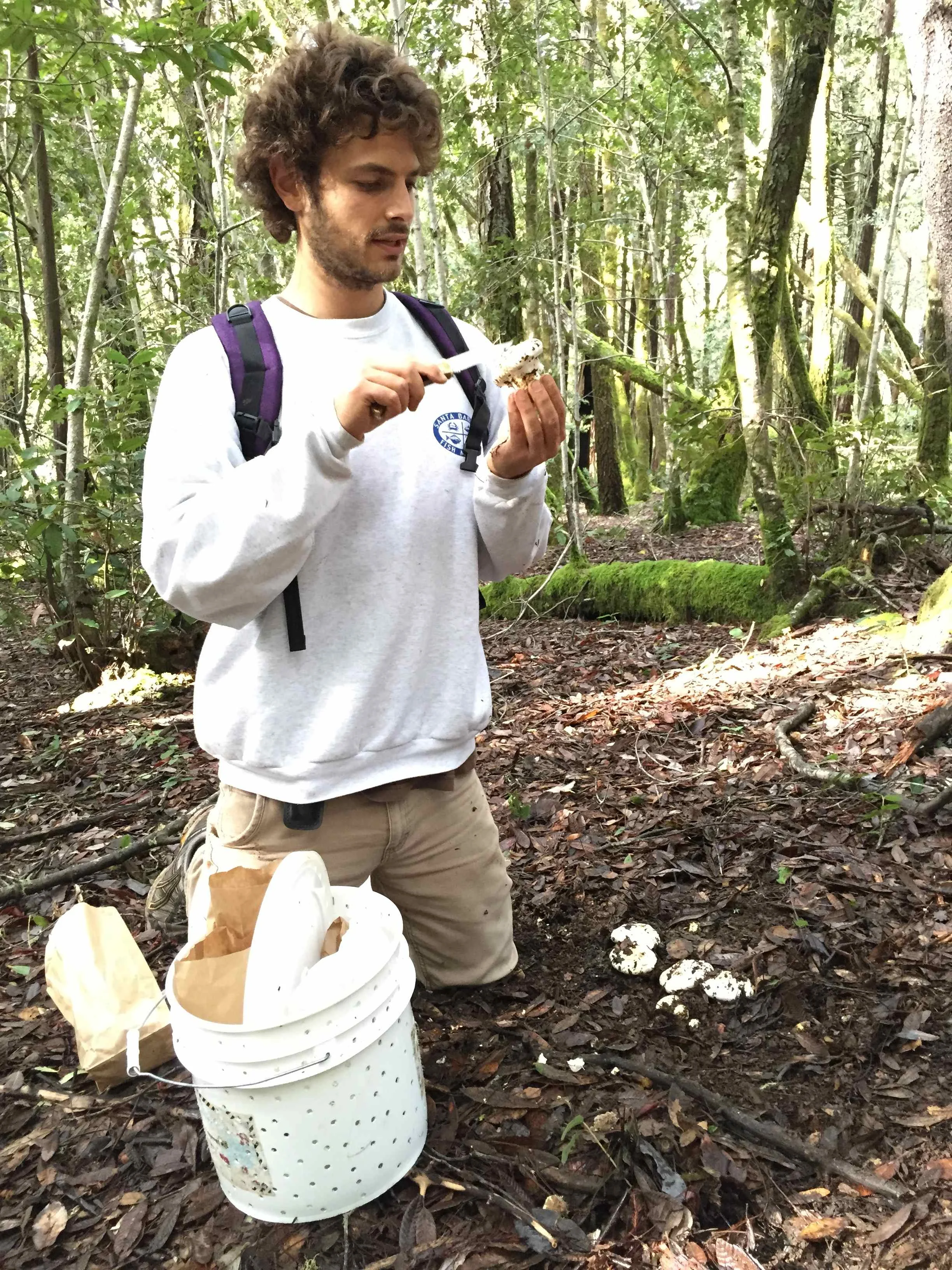













California Evergreen Huckleberries
Slightly tart and packed with flavor, I can never get enough of these delicious berries when they're fruiting north of the Bay in August through October. I often describe the flavor of huckleberries as a mix of blueberries and blackberries, but really they have a complexity all their own. These are hand-harvested using a technique known as "spanking," then meticulously sorted to remove debris. The evergreen or California huckleberry has smaller fruit than other huckleberry varieties, and there is nothing easy about the process of harvesting or cleaning them. But damn are they delicious.





Morchella





























































































































































































